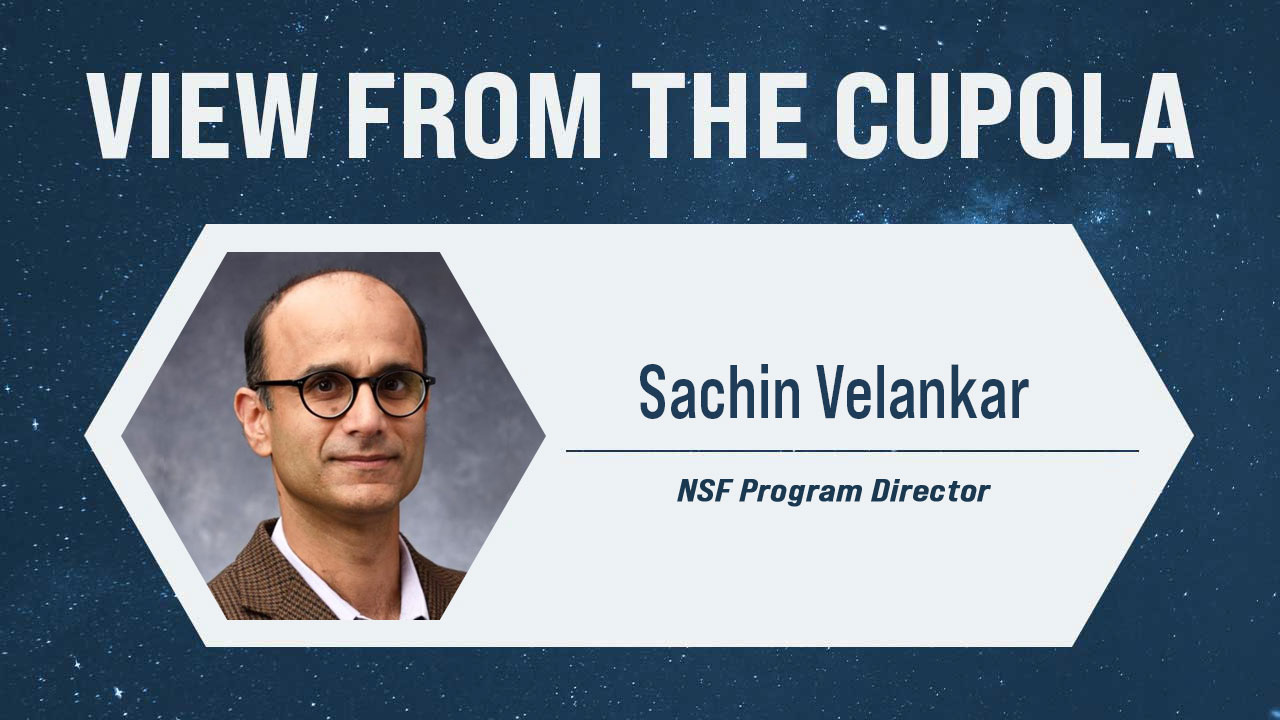View From the Cupola: Sachin Velankar

November 19, 2025 • By Sachin Velankar, NSF Program Director
Up. That’s where hot air rises and bubbles float. Down. That’s where everything falls—but not in space.
Objects float aimlessly, and fluids are even less predictable. Liquid drops may bounce off surfaces, break into smaller droplets, spontaneously accumulate in corners, or remain beaded up. How to manipulate fluids that don’t go where expected has been a NASANational Aeronautics and Space Administration focus for as long as there has been a space program. In space, bubbles can block fuel lines because liquid fuel does not drain downward, and fires may spread in unexpected directions because hot air does not rise upward.
But the lack of gravity also offers unrivaled opportunities to investigate fluid flow phenomena that would simply not be possible on Earth. Almost a decade ago, the U.S. National Science Foundation (NSF) partnered with the Center for the Advancement of Science in Space® (CASIS®) to provide researchers with access to the only national laboratory in space. Since then, NSF has committed more than $46 million to space-based research across the physical and life sciences and has supported more than 70 ISSInternational Space Station National Lab-sponsored projects. On the ground, researchers could not observe the phenomena of interest because gravity would dominate and altogether suppress them. This Upward issue highlights some of the research supported by NSF through this partnership.
In one article, a University of California, Santa Barbara team uses light to drive bubble motion. This NSF-funded research exploits Marangoni flow, a phenomenon seen at a kitchen sink: sprinkle soap (a surfactant) into dirty dishwater, and the debris will move outward from the drops. This is because the surfactant reduces surface tension, causing an imbalance in force at the surface. The team designed photosensitive surfactant molecules that reshape almost instantly under light, altering surface tension and propelling bubbles. On Earth, buoyancy overwhelms such subtle forces, so microgravityThe condition of perceived weightlessness created when an object is in free fall, for example when an object is in orbital motion. Microgravity alters many observable phenomena within the physical and life sciences, allowing scientists to study things in ways not possible on Earth. The International Space Station provides access to a persistent microgravity environment. is essential to see the movement. This research opens paths toward microscale heat transfer in electronics and precise fluid control in space systems.
The topic of another article can also be seen in the kitchen: when a wet finger circles the rim of a wine glass, the glass sings due to the vibrations. But if the glass is partly filled with water, these vibrations cause waves on the surface. A University of Florida team examined such Faraday waves on the ISS in an NSF-funded investigation. On Earth, Faraday waves are affected by gravity and surface tension. But in microgravity, they are completely different, opening avenues for applications like rapid heat transfer. The team, along with Japanese collaborators, also leveraged the ISS to observe waves on the surface of molten metal drops to measure surface tension, which is important for applications like 3D printing of metals and precision soldering.
In the cover story, we turn from inanimate bubbles and fluids to microorganisms. Although not funded by NSF, a project from the University of California, San Diego and NASA’s Jet Propulsion Lab provided valuable insights into microbes in space. We imagine the ISS as an immaculate environment, and NASA takes elaborate precautions to sterilize everything before launch. But myriad microorganisms stow away on astronauts and colonize all corners of the ISS. The team is mapping this microbial community to understand how life adapts in space. Some adaptations include antibiotic resistance, which raises concerns. Will microbes pose a risk to astronauts on long-duration missions?
I grew up an avid fan of science fiction, most of it related to space travel (shout-out to Arthur C. Clarke). So I have been excited and privileged to participate in this NSF-CASIS partnership for the last two years. Many of my fellow NSF Program Directors have been involved for several years, and working with our CASIS(Abbreviation: CASIS™) The nonprofit organization that manages the ISS National Lab, which receives at least 50 percent of the U.S. research allocation on the International Space Station to facilitate research that benefits humanity (NASA manages the other 50% and focuses on research for space exploration purposes). colleagues to evaluate the amazing research proposals is an annual highlight. It’s thrilling to learn how scientists can leverage microgravity to test fluid flow theories, measure fluid properties, and fabricate new materials.
NSF’s mission is to advance scientific progress, and one way we do this is by providing research infrastructure beyond the capabilities of a single investigator or institution. The NSF-CASIS partnership represents the ultimate example of exceptional infrastructure—a laboratory that is, quite literally, beyond this world.